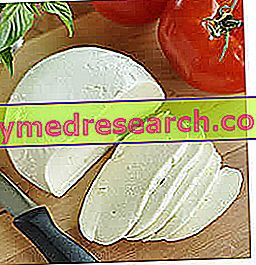Generality
Mozzarella is a dairy product, or a non-seasoned derivative of milk that preserves measurable quantities of lactose. More in detail, mozzarella is a fresh cheese with a spun and soft dough that lends itself to IMMEDIATE CONSUMPTION.

The most popular types of mozzarella are buffalo mozzarella (the one in Campania is the only one that also has the mark of origin in storage), mozzarella fior di latte (or cow 's milk mozzarella), mixed and smoked mozzarella; the burrata is quite similar but, due to the typical very oily composition, it cannot be superimposed on any mozzarella. There are also mozzarellas of various shapes: spherical (round), with head, bite-sized or cherry, braided etc., as well as of different chemical composition: light mozzarella, mozzarella with low water content (for pizza) etc.
History of mozzarella : mozzarella is a typical food of the Mediterranean basin; the warm climate of these areas has induced its inhabitants to take advantage of the rapid acidification of the milk and the related coagulation for the production of mozzarella.
Some argue that mozzarella, initially produced only from buffalo milk, has origins far before the birth of Christ; the finds are difficult to interpret but it seems that the first buffalo farms were introduced by the Greeks. Others attribute the advent of these animals to ethnic groups such as the Longobards or the Normans; what is certain is that the massive diffusion of mozzarella in the area can be traced back to the twentieth century, with the spread of peninsular farms (although mainly in the south) and the export of dairy technology abroad.
The "classic" mozzarella is undoubtedly that buffalo bell, an area in which it has acquired a further gastronomic value as a fundamental ingredient of the "pizza margherita". Currently, in Italy, mozzarella is produced mostly in the south on an artisanal or semi-industrial scale, while in the northern regions there is an important production at the industrial level; similar cheeses are also produced and exported in other countries. Fortunately, for some years mozzarella has been given the typicality certificate (STG, CEE) based on the description in the UNI 10537 sheet.
Production
The production cycle of mozzarella is typical of pasta filata cheeses.
To produce mozzarella it is possible to use raw or more commonly pasteurized milk; in the first case the food already has the lactic microorganisms necessary for acidification, while in the second it is necessary to use a graft (addition of lactic bacteria or residual acidified whey from a previous cheese-making process). In general, however, the use of raw milk is avoided, both for microbiological safety reasons and for the variability of the intrinsic microbial flora and the consequent impossibility to foresee and standardize the duration of the production phases and the uniformity of the product.
PLEASE NOTE: to obtain mozzarella from a pasteurized milk, it is essential that raw milk is subjected to SLOW pasteurization (70 ° C for 3-5 minutes); in fact, at higher temperatures, caseins undergo alterations that can compromise the spinning of the cheese. This explains why the homemade production of mozzarella with whole milk purchased at the supermarket is almost impossible.
Homemade Mozzarella
X Problems with video playback? Reload from YouTube Go to Video Page Go to Video Recipes Section Watch the video on youtubeTraditional, classic production of mozzarella with lactic ferments
The pasteurized whole milk is brought to a temperature of 33-36 ° C and subjected to coagulation and biological acidification by adding:
- rennet (typically of veal, title 1: 10.000, if solid in doses of 0.35-0.4 g / L, if liquid in doses of 30-35 ml ml / hl)
- and a microbial trigger (lactic bacteria, typically Streptococcus thermophilis strains, or acidified residual serum) *.
After this phase the milk is left to rest for the time necessary to coagulate (about 30 minutes). This is followed by a first cut (breaking) of the cubed curd, a rest period of about 5-15 minutes, and a second cut into smaller cubes (hazelnut). The remaining mass is then partially separated from the whey and left to mature (acidify) first under the remaining serum and then on a controlled temperature drainage table for 3-6 hours and in any case until a pH of between 4.9 and 5 is reached. 2 (essential for mozzarella to be spinnable). The duration of the maturation period varies according to the acidifying activity of the microbial starter used and the conditions in which it works (type of milk, temperature, humidity, etc.); in case of raw milk the time required to obtain sufficient acidification could extend up to 48 hours. During maturation, the activity of starter lactic bacteria (or those naturally present in raw milk) leads to the formation of metabolism products which, in addition to the acidification of the curd, enhance the organoleptic characteristics of the product.
The acidification process of the curd and the pasta is essential for a good production of mozzarella, since it allows the subsequent spinning . To be able to spin, in fact, the starting pasta must have a certain degree of acidity, which can be obtained by fermentation by microgarnisms (traditional technique, see above), by adding citric or lactic acid (industrial technology, see beyond), or with mixed systems.
After 10-30 minutes of maturation under serum (up to pH 5.6-5.8), the acidified paste is racked onto drainage tables (room temperature 20-25 ° C) and possibly cut into pieces and turned over to favor the separation from the serum while the maturation is completed. Once the desired pH is reached, the actual spinning is anticipated by cutting the pasta into pieces and the subsequent immersion in hot water (80-85 ° C for the vaccine, 92-95 ° C for the buffalo), which infuses a temperature to heart of the dough equal to 58-62 ° C; with hot pasta, spinning and forming take place much more easily. Before undertaking the spinning of the pasta, beyond the pH control, it is essential to carry out an empirical test of spinning; it consists of finely crushing a handful of curd with your hands and throwing it into a ladle containing water at a temperature of about 85 ° C; the curd is then melted with a wooden stick and stretched until a continuous thread is obtained (here the skill and experience of the cheesemaker come into play: indicatively, the test is positive if 10 grams of curd give a thread a meter long ). The spinning essentially consists in ironing the curd paste, softened by immersion in hot water, until it becomes a braid of silky, glossy and soft, but above all plastic and formable, from which you can detach the rounded pieces that, once "Severed", that is detached by twisting from the braid, they are molded into the desired shape and made to consolidate by cooling them in water. The mozzarellas, in particular, are consolidated by immersion in cold running water (which must be kept so, at 8-10 ° C) for 30-60 minutes, possibly placed in brine and packaged with the governing liquid (improperly called "buttermilk" ).
A "traditional" mozzarella on the label will therefore show only four ingredients: milk, lactic ferments, rennet and salt. It will also be poorer in lactose, as it is consumed by the raw milk micro-organisms (or those grafted) compared to the industrial counterpart.
Industrial production of mozzarella with citric acid
* At the industrial level, a particular type of mozzarella obtained by additive acidification (and not organic, therefore without starter) is more widespread due to the addition of citric acid, which accelerates (and above all standardizes) production times and limits costs. In fact, with the addition of citric acid (1.1 / 1.3 grams per liter of milk placed in a 6-10% aqueous solution) to cold milk (15 ° C) under stirring up to pH 5.6- 5.8, the paste coming out of the coagulation is almost ready for spinning (it does not need the 3-6 hours of maturation seen previously). In essence, organic acid (citric and / or lactic and / or gluconodeltalactone) is added to cold milk (8 ° -16 ° C), it is slowly heated up to a temperature of 33-35 ° C, rennet is added (typically veal, title 1: 10, 000 in doses of about 0.35-0.4 g / L) and is left to rest for 30 minutes. The curd is broken and, after having left a few minutes to settle and acidify, as soon as it begins to bind, it is extracted leaving it to drain from the excess serum for a few minutes before passing directly to the spinning, which takes place at a slightly higher pH than to the artisan procedure (5.6 - 5.8).
PLEASE NOTE: instead of citric acid you can use lemon juice calculating that it naturally contains about 5-10% (then add the filtered and cold juice of 1 - 1.5 kg of lemons per hectolitre of milk ). This way you will get a mozzarella with a lemon aftertaste not everyone likes.
This "industrial" mozzarella is recognized because in the list of ingredients there is the presence of an "acidity corrector", which as we have seen may be: citric acid and / or lactic acid and / or gluconodeltalactone acid. It is typically richer in lactose, therefore sweeter but less digestible, has a less intense aroma (a more anonymous flavor), a less soft consistency and can be preserved for a longer time.The quality is therefore lower even if the acids used, such as the citric acid, are anyway "natural ", being abundantly present in nature (for example in lemons and oranges).
Video Recipe - Homemade Mozzarella with Citric Acid
There are also mixed methods in which the acidification of the curd is obtained both by the addition of chemical additives (citric acid, etc.) and biological additives (microbial starters).
Powdered milk mozzarella : there is a type of mozzarella obtained by recombination of milk-based raw materials, or through the rehydration of powdered milk and the emulsion of the fat component, followed by the normal cheesemaking process). In one study, Garem et al. (2000), by:
- The solution of dehydrated and microfiltered caseins (to the detriment of those of whey, discarded upstream of the processing process)
- The addition of lipids (only milk cream or with the use of anhydrous fat and butter oil)
- Achieving a temperature of 40 ° C (which allows the fats to be melted more)
they obtained a mozzarella cheese with higher yields than those of fresh milk (12.7% vs 11.8%).
Hygienic aspects and nutritional characteristics
Mozzarella food safety : packaged mozzarella offers good hygienic guarantees; those from pasteurized milk are obviously healthier, but even raw milk mozzarellas do not involve great risks of contamination, thanks also to the spinning that requires medium-high temperatures (however lower than those of pasteurization). The possible undesired microbiological proliferation is manifested by yellowing of the mozzarella and formation of superficial patinas and bad smells.
Today the loose sale of mozzarella is no longer allowed; moreover, it would always be advisable to consume it within a few days of production or possibly, only for those placed in aseptic conditions, up to 2-3 weeks.
The intentional additives that can be present in the mozzarella are: lactic acid, citric acid and gluconodeltalone, important - as we have seen - to accelerate the acidification process.
The composition of the mozzarella is quite variable; the Italian mozzarella is richer in water (52-60%), while the American mozzarella or Pizza Cheese is more concentrated (only 45-52% of water); the buffalo mozzarella is fatter than the mozzarella and other small differences can be observed among the various types available on the market.
Nutritional properties of mozzarella : mozzarella is one of the least fatty cheeses on the market; excluding the burrata and the buffalo (more fat, therefore caloric), the vaccine mozzarellas provide an average of 250 to 290 kcal per 100g of edible portion.
The proteins, mainly caseins, are present in varying quantities and appear greater in the vaccine mozzarella; the prevalence of amino acids is in favor of: ac. glutamic, lysine and aspartic acid, while the limiting amino acid is TREONINA. On the other hand, fats - mostly saturated - and lactose are higher in buffalo mozzarella, which is also richer in caseins than cow's milk. Cholesterol is NOT excessive.
From the saline point of view, a good but not excellent calcium and phosphorus content is found, while the sodium (although it is a cheese) is well present but in moderate quantities. As far as vitamins are concerned, excellent concentrations of riboflavin (vit. B2) and retinol (vit. A) are inferred.
Mozzarella represents one of the few cheeses that can be contextualised in the hypocaloric diet (as long as it is NOT seasoned with oil), hyposodic (therefore against hypertension) and against hypercholesterolemia, even if the portions and frequency of consumption must be at least moderate.
Mode of consumption: mozzarella is consumed mainly on pizza, in the typical "caprese" dish, in "carrozza" (or on slices of bread) and fried battered. Mozzarella does not lend itself much to the combination with wine or beer, except if present on the pizza.
Vegan Mozzarella
In the video our personalcooker shows how to prepare the vegetable alternative to animal mozzarella, similar in appearance and consistency but quite different in flavor, however pleasant.
Vegan Mozzarella - Vegetable Mozzarella without Cholesterol
X Problems with video playback? Reload from YouTube Go to Video Page Go to Video Recipes Section Watch the video on youtubeNutritional composition of mozzarella - Reference values of the INRAN Food Composition Tables
Nutritional composition for 100 grams of edible part of the Fior di latte, buffalo mozzarella, cow's mozzarella:
| Milk cream | Buffalo mozzarella | Cow mozzarella | ||
| Power | 268, 0kcal | 288, 0kcal | 253, 0kcal | |
| Edible part | 100, 0g | 100, 0g | 100, 0g | |
| water | 54, 8g | 55, 5g | 58, 8g | |
| Protein | 20, 6g | 16, 7g | 18, 7g | |
| Lipids TOT | 20, 3g | 24, 4g | 19, 5g | |
| Saturated fatty acids | - mg | - mg | - mg | |
| Monounsaturated fatty acids | - mg | - mg | - mg | |
| Polyunsaturated fatty acids | - mg | - mg | - mg | |
| Cholesterol | - mg | - mg | 46, 0mg | |
| TOT Carbohydrates | 0.7g | 0.4g | 0.7g | |
| Complex glucides | 0.0g | 0.0g | 0.0g | |
| Soluble sugars | 0.7g | 0.4g | 0.7g | |
| Dietary fiber | 0.0g | 0.0g | 0.0g | |
| Sodium | - mg | - mg | 200, 0mg | |
| Potassium | - mg | - mg | 145, 0mg | |
| Iron | 0.4mg | 0.2mg | 0.4mg | |
| Football | 162, 0mg | 210, 0mg | 160, 0mg | |
| Phosphorus | 355, 0mg | 195, 0mg | 350, 0mg | |
| Thiamine | 0, 03mg | - mg | 0, 03mg | |
| Riboflavin | 0, 27mg | - mg | 0, 27mg | |
| Niacin | 0, 30mg | - mg | 0, 40mg | |
| Vitamin A | 300, 0μg | 164, 0μg | 219, 0μg | |
| C vitamin | 0, 0mg | 0, 0mg | 0, 0mg | |
| Vitamin E | - | 0, 24mg | 0, 39mg | |
Bibliography:
- Cheese Atlas - G. Ottogalli - Publisher Ulrico Hoepli Milan - page 205: 210
- Microbiology and dairy technology. Quality and safety - G. Mucchetti, E. Neviani - New techniques - pag 389-390
- Residues, additives and food contaminants - G. Cerutti - Tecniche Nuove - pag 154.



